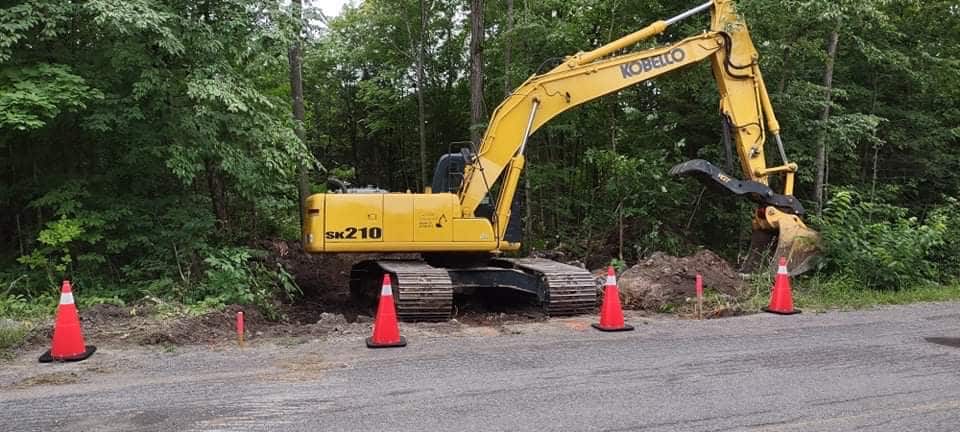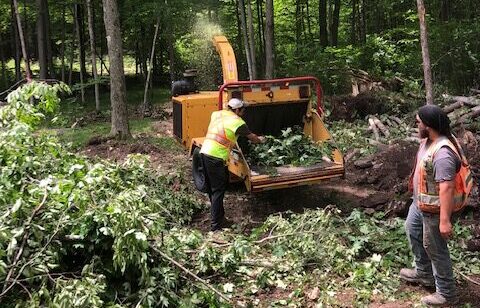When preparing a property for construction, agriculture, or redevelopment in Ontario, one of the first decisions you’ll face is the extent of vegetation removal. Specifically, should you opt for brush clearing or full land clearing? The distinction between these two approaches can significantly affect your project’s cost, environmental impact, and equipment requirements. At M. Riddle Excavating, we regularly guide property owners through these choices during early site preparation and grading work, helping them align their land clearing strategy with their budget and long-term plans.
Whether you’re dealing with an overgrown rural lot near Kingston or prepping a development site in Napanee or South Frontenac, understanding the difference between brush clearing and full land clearing is critical to making an informed decision.
What Is Brush Clearing?
Brush clearing is the selective removal of undergrowth, shrubs, tall grass, and small trees. It is typically used when the goal is to tidy up a site without disturbing larger trees or the natural landscape more than necessary. This method is common for managing rural lots, fire prevention, or improving access paths and fence lines.
Brush clearing can be performed using light to moderate equipment, such as skid steers with brush cutters or forestry mulchers. In some cases, chainsaws and manual labour may still play a role for precision work. Unlike full land clearing, brush clearing focuses on surface vegetation and avoids deep soil disturbance.
Because it preserves the overall character of the land, brush clearing is ideal for clients looking to control overgrowth without removing mature trees or altering topography. We often recommend this approach for property owners preparing for future builds, where visual access and surveying are needed before committing to excavation or construction.

What Is Full Land Clearing?
Full land clearing involves removing all vegetation, including large trees, stumps, brush, and sometimes even topsoil layers. The objective is to completely prepare a site for development by creating a clean slate. This type of land clearing is typically required for projects such as new home builds, septic system installation, roadwork, or commercial development.
To execute full land clearing, heavier equipment is used, including excavators with root rakes, bulldozers, and forestry mulchers. In some cases, tree shears or feller bunchers are also deployed. The process often includes stump removal, debris hauling, and ground levelling to ensure the area is ready for trenching, grading, or foundation work.
Because it involves deep disturbance of soil and ecosystems, full land clearing can trigger environmental considerations and even permitting requirements depending on the scope and location. In Ontario, some municipalities require erosion control plans or environmental assessments for larger clearing operations. For example, the City of London’s 2025 Design Specifications & Requirements Manual states that an Erosion and Sediment Control (E&SC) Plan is required for most developments, city capital, and operational projects.
Cost Comparison: Brush Clearing vs Full Land Clearing
From a budget standpoint, brush clearing is the more economical option. Rates are typically lower due to the lighter equipment required and shorter labour timelines. Brush clearing jobs can often be completed within a few hours to a couple of days, depending on the size of the lot and density of vegetation.
Full land clearing, on the other hand, comes with significantly higher costs. This includes machinery transport, operator time, disposal or chipping of organic material, and possible permit applications. The cost increases further if the land has steep slopes, rocky soil, or mature hardwood stands that require precision removal.

Environmental Considerations
Environmental impact is another key factor when comparing brush clearing with full land clearing. Brush clearing, by nature, is less invasive. It retains the root systems of larger trees and avoids disturbing soil structure, which helps prevent erosion and protects local biodiversity. Research underscores how brush mulching – or forestry mulching, a form of brush clearing – tends to protect soil integrity, reduce erosion, and support ecosystem health. Mulching leaves organic material on site that nourishes soil and limits sediment loss, whereas more traditional clearing disrupts soil and often leads to long‑term erosion and biodiversity loss. It’s often used in environmentally sensitive areas or zones where tree preservation is a priority.
Full land clearing, while necessary for certain builds, removes more than just vegetation. Uprooting stumps and stripping topsoil can cause runoff, disrupt wildlife habitats, and increase the risk of erosion. That’s why some municipalities in Ontario require sediment control measures or restrict clearing during nesting seasons. We stay current with Ontario’s environmental regulations and integrate responsible clearing practices into all our projects, from septic installations to site prep for new builds.
For example, mulching cleared material directly into the soil helps reduce erosion and enhances soil stability. In other cases, we may recommend phased clearing or buffer zones to protect wetland edges or mature tree lines.
What Equipment Do We Use for Each Approach?
Brush clearing typically involves compact, nimble equipment like skid steers with rotary cutters, forestry mulchers, or grapple buckets. These machines can manoeuvre in tight spaces and handle moderate vegetation without damaging the surrounding landscape. Manual clearing tools may also be used for fence rows or detailed work.
In contrast, full land clearing demands heavy-duty machines. Excavators equipped with root rakes are used to dig out stumps and rocks. Bulldozers help push material into piles for disposal or burning, depending on local bylaws. When needed, forestry mulchers can process trees and brush into usable mulch right on site, minimizing hauling requirements.
Our equipment choices are always based on the project scale, accessibility, and soil type. For example, clearing a flat residential lot with light brush requires very different methods than clearing a forested hillside for a septic field. If you’re unsure which method is right for your site, we recommend reaching out to our team to discuss your property’s specific needs.
When to Choose Brush Clearing Over Full Land Clearing
Choosing between brush clearing and full land clearing depends on your end goal. If your priority is aesthetic improvement, fire hazard reduction, or gaining visibility for surveying, brush clearing will likely meet your needs at a lower cost and with minimal impact. It’s often the first step in early-stage development and can help you visualize how to shape the land without committing to heavy excavation.
Full land clearing, however, is the right choice when you’re ready to begin building, install a septic system, or complete major grading work. For example, septic system design and installation projects often require full land clearing to accommodate tanks, leaching beds, and piping. You can see examples of how land was cleared for this purpose in several of our previous projects.
If you’re unsure whether you need light or full removal, our team can walk the site with you and provide insight into what’s necessary for code compliance and construction access. It’s part of the value we bring to each job – not just clearing land, but doing it in a way that supports long-term durability and sustainability.
Make the Right Choice for Your Land Clearing Project
Whether you’re brushing back overgrown vegetation or starting from scratch with a clean site, it’s important to choose the right land clearing method for your goals, budget, and local regulations. At M. Riddle Excavating, we combine technical knowledge with practical experience across a wide range of property types and terrains throughout Kingston, Napanee, South Frontenac, and the surrounding area.
Land clearing is more than just clearing space. It sets the tone for everything that follows, from site drainage and foundation stability to environmental compliance and permitting. Our team is equipped to handle both brush clearing and full land clearing with the care and expertise that ensures your land is prepared safely, efficiently, and in line with the latest municipal and provincial standards.
To speak with an expert about your land clearing needs, contact us today. We’re happy to walk you through the process, assess your site, and deliver a custom quote tailored to your goals.

